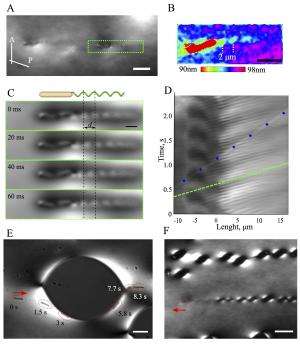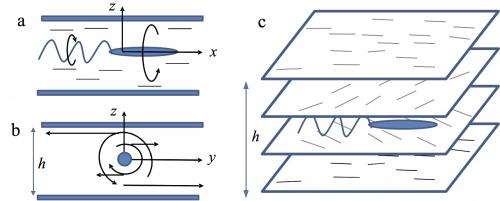January 31, 2014 feature
It's alive! Scientists combine liquid crystals and living bacteria

(Phys.org) —The prospect of integrated living organisms into a non-living substrate has long held a compelling appeal for those investigating active matter – the study of a type of easily-deformable out of equilibrium soft matter that focuses on the properties of assemblages of self-propelled interacting particles, and an important physical model of living systems. Recently, scientists at Kent State University, Argonne National Laboratory and Northwestern University have proposed the living liquid crystal (LLC) – a new class of active matter with motile rod-shaped bacteria placed in a water-based nontoxic lyotropic liquid crystal (LC) environment. The researchers found that the novel material displays a wide range of useful and occasionally surprising properties that lend themselves to a wide array of potential biosensing, biomedical, submicrometer, autonomous microprobe, and structural imaging applications.
Dr. Igor S. Aronson discussed the paper that he, Researcher Shuang Zhou, Dr. Andrey Sokolov, and Dr. Oleg D. Lavrentovich published in Proceedings of the National Academy of Sciences. "When we first combined living swimming bacteria with a liquid crystal, it wasn't clear that the bacteria could live and swim in the liquid crystal, or if the liquid crystal is consistent with the bacterial environment," Aronson tells Phys.org. To address this, the scientists developed a protocol for transferring bacteria to the liquid crystal by suspending the water-soluble liquid crystal used in their experiment in the bacterial growth medium.
Another challenge the researchers faced was determining that long-range orientational order of the liquid crystal and the swimming activity of bacteria demonstrate a strong coupling that dramatically alters individual and collective bacterial dynamics. "We found that in the liquid crystal environment we can see bacterial flagella, which are only about 20 nm wide," Aronson says. More specifically, they observed a birefringence-enabled visualization of microflow generated by the flagella. (Birefringence is the optical property of a material having a refractive index that depends on the polarization and propagation direction of light.) "This is a very surprising discovery," Aronson acknowledges. "Due to liquid crystal birefringence, we can flagella in polarized light – and remarkably, this is a non-invasive technique."
"This observation is possible due to strong coupling between the long-range orientational order of the liquid crystal and bacterial activity." Specifically, nanometer-wide bacterial flagella induce distortions in the liquid crystal on the scale of microns due to orientational order in the liquid crystal – and as a result, these flagella-induced distortions are visible in polarized light. Previous observations of flagella were made either by tunneling electron microscopy, which required drying the bacteria, or fluorescent microscopy, which required a significant modification of the bacteria (for example, by labeling their flagella with fluorescent dyes). "
Moreover, the scientists found a dynamic phenomena caused by coupling between the activity-triggered flow and long-range orientational order of the medium. In one such case, the scientists observed that the bacteria closely follow the local nematic direction. "This is primarily caused by strong viscosity anisotropy (the property of being directionally dependent, as opposed to isotropy) in the liquid crystal, Aronson comments. In addition, he points out, that moving perpendicular to the local nematic direction is not energetically favorable since it causes strong distortions of the local orientational order.

Furthermore, the scientists discovered that bacterial activity results in this emergence of self-organized textures – for example, stripes – from initially uniform LLCs. The textures emerged with a characteristic length x controlled by a balance between bacteria activity and anisotropic viscoelasticity of the liquid crystal. "The characteristic length decreases with increases in bacterial concentration and bacterial swimming speed," Aronson explains. "Also, x increases with an increase in experimental cell thickness." The primary reason for the onset of the self-organized textures is a competition of two effects: the LC tends to align the bacteria along local nematic direction – but bacteria generate flow in the LC which deflects LC molecules from their initial orientation. (A nematic liquid crystal phase is characterized by molecules that have no positional order but tend to point in the same direction.) The characteristic length can therefore be estimated by comparing viscous torque exerted by the bacteria on the LC molecules with the restoring elastic torque in the LC.
The researchers also demonstrated activity-triggered transitions from a non-flowing uniform state into a flowing one-dimensional periodic texture, and its subsequent evolution into a turbulent array of topological defects. "We observed a gradual increase in the complexity of emerging self-organized textures," Aronson tells Phys.org. "At the onset – that is, at a very low concentration of bacteria – we observed the emergence of near-periodic arrays of stripes oriented perpendicular to the original nematic direction. Furthermore, with an increase in the concentration of bacteria, we observed the onset of disclinations" – the nucleation and proliferation of defects – "in the stripe arrays." For even high concentration of bacteria, he notes, the overall texture is chaotic, with disclination pairs appearing and annihilating seemingly in a random fashion – a state known as active turbulence.
Aronson notes that their work provides several key insights derived from addressing the challenges they encountered:
- it demonstrates universal features of the collective motion of self-propelled particles (such as bacteria) in anisotropic media (LC) – for example, the emergence of self-organized textures with a characteristic scale controlled by bacterial activity
- the possibility of observing nanoscale dynamic objects, like bacterial flagella, in polarized light
- the possibility of controlling and manipulating bacterial trajectories n the LC environment
- a design concept for rewritable microfluidic devices based on their demonstration that the bacteria follow nematic-isotropic boundaries (isotropic – that is, uniform in all orientations –domains can be created in liquid crystals by, for example, local heating with lasers and then erased by cooling the liquid crystal)
In addition to these insights, the study uncovered a number of interesting and sometimes surprising results. Addressing the nonequilibrium nature of the collective motion of self-propelled organisms or synthetic particles, Aronson says that self-propelled microorganisms or synthetic swimmers inject energy into the medium at the microscopic scale (that is, the scale of individual particles), which drives the system out of equilibrium.

Yet another interesting finding is that of local melting of the liquid crystal caused by the so-called shear flows produced by bacteria. "With the increase in temperature, nematic and isotropic phases begin to co-exist in a manner analogous to water and ice," Aronson explains. "Rotating bacterial flagella shear LC molecules, thus causing it to melt."
Finally, notes Aronson, similar studies can be done with of more complex living liquid crystals, including smectics, where molecules form layers that can slide over one another, or cholesteric, in which molecules form helix-like order. In such cases, the scientists expect to find new types of emergent textures
Beyond their own work, Aronson sees a range of other research areas that stand to benefit from the results of their study. One such area, he says, comprises biosensing and biomedical devices with unique functionalities, including specific responses to chemical agents, toxins, or photons. "This technique can be used to control and manipulate individual bacteria for the purpose of recognition, analysis, and identification. For example," Aronson illustrates, "one may think of modifying bacteria to have a specific sensitivity to a particular chemical agent, such as a toxin." Once the agent is introduced into the cell, bacteria begin to move, thereby triggering the onset of periodic stripes. These stripes can be immediately detected – and in the case of light-sensitive bacteria, can be controlled by light.
Swimming bacteria can also serve as autonomous microprobes for determining liquid crystal properties. The bacteria create perturbations in the LC over a wide range of scales, from nanometer (flagella) to hundreds of micrometers (emergent textures). "By studying the LC response to bacterial motion," Aronson concludes, "we can extract valuable information on LC material properties in confined geometries, such as microchannels. We can also study interaction of nearby swimming bacteria, including flagella interaction effects."
More information: Living liquid crystals, Proceedings of the National Academy of Sciences published online before print on January 13, 2014, doi:10.1073/pnas.1321926111
Journal information: Proceedings of the National Academy of Sciences
© 2014 Phys.org. All rights reserved.




















